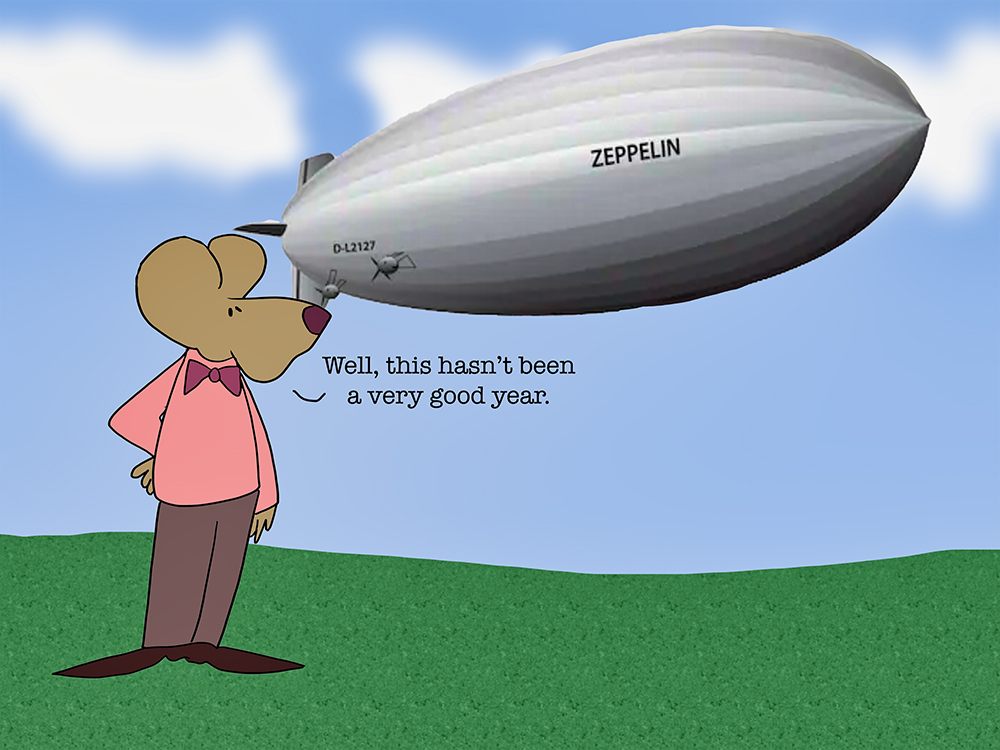I think when most of us hear the name Zeppelin, we think of one of two things. Either the rock group, Led Zeppelin, or the airships of the early 1900s. And of course, the Hindenburg disaster.
Those aircraft were named for a German man, Ferdinand Adolf August Heinrich Graf von Zeppelin. And I thought Polly Cecile Constance Kronenberger was long.
There isn’t much written about his childhood. He was born in 1838. They were wealthy, it seems, and he spent his entire youth with his sister and brother at their manor near Konstanz. As you look at a map, it is south of Stuttgart, very near Zurich. Anyway, he and his siblings were educated by private tutors. When he turned 20, Zeppelin joined the army and became a member of an expedition that went to North America. They were, of all things, searching for the source of the Mississippi River.
I’m not sure what year he came to America, but eventually wound up in Minnesota, where he made several balloon ascents at St. Paul, as a military observer for the Union Army. This was during the Civil War, so, somewhere between 1861 and 1865. It was this duty that triggered his fascination for balloon aviation. Jump ahead. Zeppelin retired from the army in 1891 with the rank of brigadier-general, and he began to study aeronautics.
Now, Zeppelin is about 60 years old when he makes the decision to invest all his money in a company producing airships. The German government rejected his ideas, so he forged ahead on his own. Within four years, at his factory in Friedrichshafen, Germany (within 10 miles from where he was born), he had assembled his first machine – the LZ1. The initials stood for Luftschiff Zeppelin. (Luftschiff is German for lift ship or airship).
These rigid airships were giant, covered steel frameworks that house gas-filled bags. The LZ1 weighed 12 tons, contained 400,000 cubic feet of gas bags. They were 420 feet long. They were driven by propellers connected to two 15 horsepower engines.
Needless to say, the government was now impressed and began pouring state money into his project. The world’s first passenger-paying airline – called Deutsche Luftschiffahrts-AG (DELAG) – began commercial flights using those Zeppelins in 1910. Things went rather well. The airline had operated more than 1,500 flights carrying over 10,000 passengers in its first four years.
Then the dreaded First World War came around. They produced military versions of the Zeppelin, which were used for air raids on Britain and France. The airships could fly 84 miles per hour and reach a height of 14,000 feet. Also, they were equipped with five machine guns and could carry 4,400 pounds of bombs.
That was all pretty impressive to the military — at first. But the airships were huge and pretty dang slow. They became an easy target for anti-aircraft guns, and 40 were shot down over London. The Germans withdrew them from military service.
Ferdinand Zeppelin died in 1917, aged 78.
After his death, the production of the Zeppelin continued under his successor, Hugo Eckener. There was a long and continued success with them, as passenger vehicles. Some of them were luxurious, even.
But there is always a hiccup. That little mistake. That little but fatal flaw. The airships, in their original design, were made to be filled with helium gas bags. But because of export restrictions by the United States against Nazi Germany, it was instead filled with bags of highly flammable hydrogen.
The year was 1937. The Hindenburg came in to land at Lakehurst, New Jersey. A small flame, at first. And then? It took only 34 seconds for the entire airship to be consumed by fire. Hydrogen works that way.
Thirty-five of the 97 people on board died, as did a member of the ground crew. And it was this accident, this horrific occurrence, that ended the legacy of the Zeppelin. Named for, of course, our guy Ferdinand Adolf August Heinrich Graf von Zeppelin.
I mentioned the British rock group Led Zeppelin, who took their name from the airship. Well. In 1970, Zeppelin’s granddaughter, Countess Eva von Zeppelin, once threatened to sue them for illegal use of their family name while they were performing in Copenhagen.
I think it was just a threat. Full of hot air, if you will.
=========
“You wanna fly, you got to give up the shit that weighs you down.”
― Toni Morrison, Song of Solomon
========
“The moment you doubt whether you can fly, you cease for ever to be able to do it.”
― J. M. Barrie, Peter Pan
=======
“Smart people learn from their mistakes. But the real sharp ones learn from the mistakes of others.”
― Brandon Mull, Fablehaven
=======
A bad case of gas
